You hear the term all the time. But when you ask what it means, the answers are all over the place. It’s a type of person. It’s a type of content. It’s a marketing strategy.
So we teamed up with friends at Mantis Research and SurveyMonkey Audience and asked 481 marketers some questions to finally answer, once and for all, what is thought leadership?
We combined the most common answers from the thought leadership survey (those with 65% agreement) into this single definition for thought leadership content:
“Educational content, produced by an expert or business, that identifies new trends and is supported by research. It challenges the thinking of the target audience and drives marketing outcomes.”
When we add some of the less common responses (those with 50% agreement), we see a more complete picture. When grouped together, you can see there are really three main qualities: expert insights, personal brand and taking a stand.
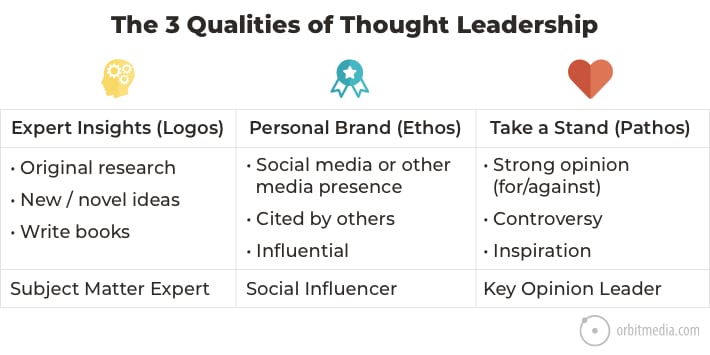
These three categories align with Aristotle’s Three Modes of Persuasion. They also align with specific digital marketing strategies and general personas.
The thought leader is at the intersection between the subject matter expert, the social influencer and the key opinion leader. Let’s look more closely at each of those key elements.
1. Thought leadership is expert insights
When asked what types of content are effective, educational/how-to content was the top answer. The consumers of thought leadership articles want to learn.
All of the information-based responses were more common than the opinion-based responses. Education is more important than perspective. Logos is more important than pathos.
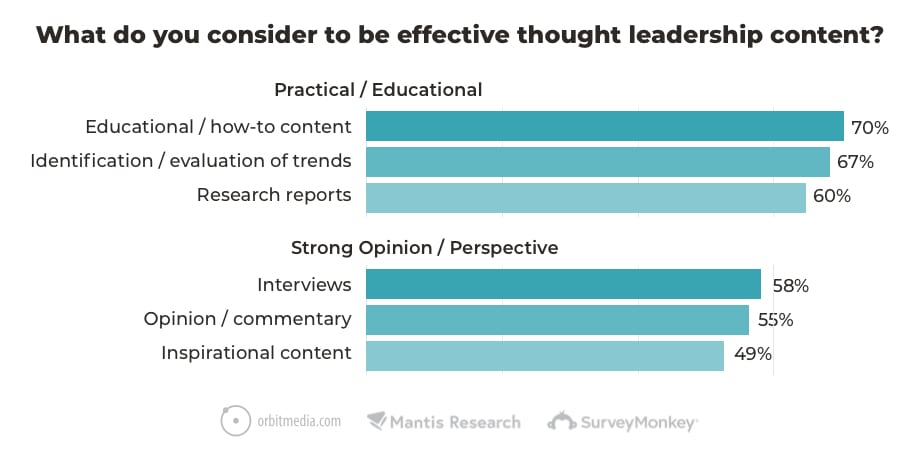
71% of respondents said “purely educational content can be thought leadership”
Who makes the best thought leaders?
Any expert can be a thought leader. A strong majority of respondents (68%) feel that expertise is what’s needed. It is the critical component.
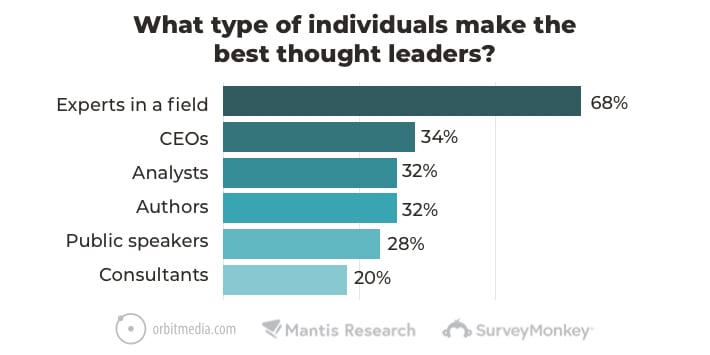
In fact, 34% of respondents said “I don’t think the type of person matters; anyone can be a thought leader.”
But role and title still play some part in credibility. Executives make better thought leaders than consultants.
And around 30% of respondents think that writers of books and speakers at events make good thought leaders. Publishing and presenting are strong plusses, but not essential. Analysts who publish original research also have an advantage.
2. Thought leadership requires a strong (personal) brand
The content needs to connect with an audience to have an impact. It’s not the best content that wins, it’s the best promoted content. Without an audience, even the most insightful content has no impact.
Can a company be a thought leader?
Yes. Surprisingly the survey shows that it doesn’t need to be a personal brand. 70% of respondents report that companies can be thought leaders. Of course a company can take a leadership position, but the thinking is always done by the people within the company.
Can thought leadership be outsourced?
And half of the respondents said that ghostwritten content can still be thought leadership content. This is also surprising to me. Apparently, the consumers of the content don’t mind if the writing is outsourced. Who created the content is not as important as the quality.
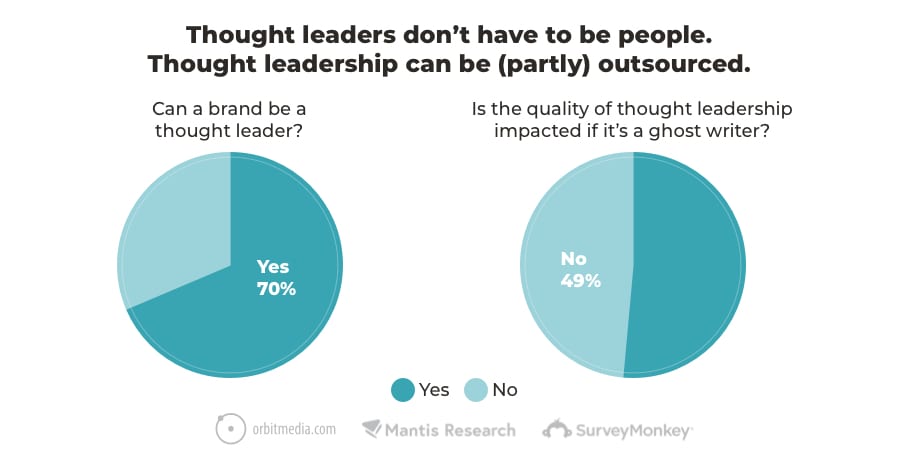
This shows the extent to which content marketing and thought leadership overlap. For marketers, it’s not essential that the thought leader be a person. A faceless company will do. And if it is a person, they don’t even have to write the content themselves.
Do thought leaders need large social media followings?
No. The survey shows that to be a leader, you must have a following, but it doesn’t need to be a social media following. Social media is one way to grow an audience, but it’s not the only way. Some through leaders reach their audience through books, columns, speaking engagements or traditional media.
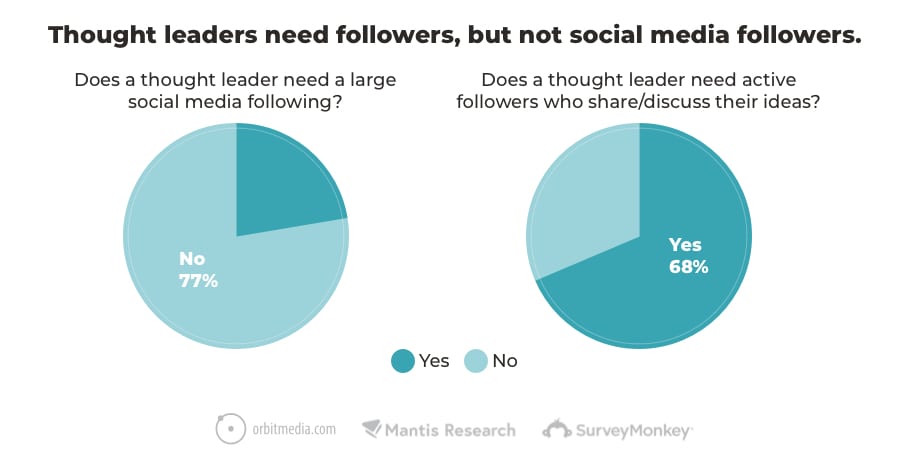
3. Thought leaders take a stand
Here we see the extent to which taking a position for (and therefore against) something is important. Typically, we follow people who have ideas rooted in deep beliefs. A person without convictions is less likely to stir emotion and drive action.
But the research shows that op/ed content is not required.
Do thought leaders need to take a stand? Or have controversial perspectives?
No. A strong point of view is essential, but they don’t have to have ideas that are unpopular or controversial.
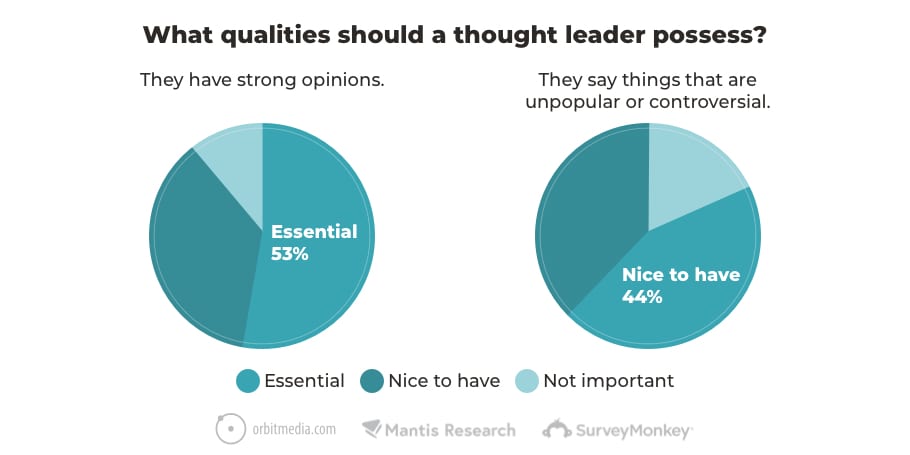
Seth Godin disagrees. I had the chance to ask him during a Q&A session at a conference. His position is that thought leadership is specifically about taking a stand. In other words, purely educational content isn’t thought leadership.
 |
Seth Godin, AUTHOR“Thought leadership always creates tension. It’s about making assertions. You have to be willing to be wrong. You can be certain that some people will disagree.” |

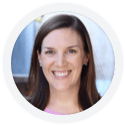 |
Lee price, THOUGHT LEADERSHIP STRATEGIST“Perspective is the heft of your earned experience. Ideas don’t just come out of nowhere. We develop ideas based on what we have seen and learned. It’s why most thought leaders are at the middle to end of their careers, not at the very beginning. So, I agree with the survey results that thought leaders certainly need an opinion. We’re not looking to thought leaders to deliver just empirical facts; we want them to LEAD us with the ideas they have developed and tested over time.” |
Is thought leadership a type of marketing?
Clearly, the panel of marketers who responded to the survey feel that it is. It is a marketing strategy with specific purposes and outcomes. This is why thought leadership is important to brands: business impact.

Is it effective? What are the outcomes?
We asked the marketers who have prioritized thought leadership if it is effective. It is. 90% reported their programs to be “very successful” or “moderately successful”
These results mapped almost exactly to the responses to the results questions from our annual blogging survey, again showing the close relationship between thought leadership and content marketing.
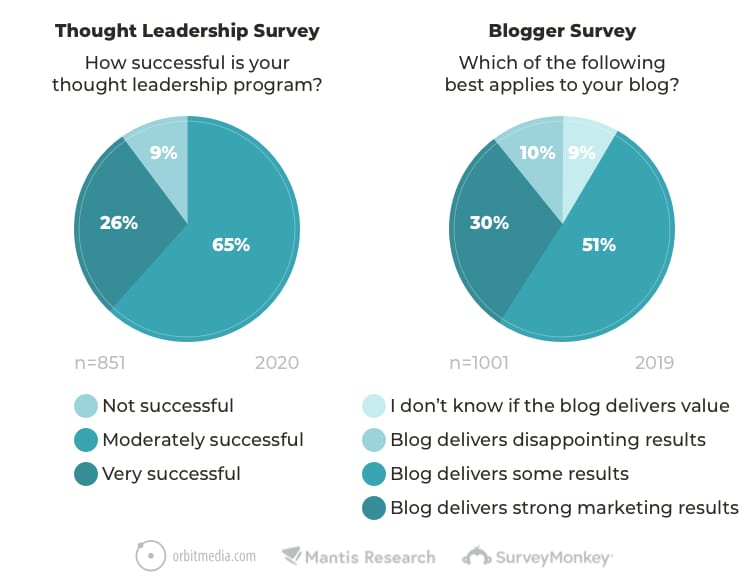
And what specific outcomes did they achieve? We asked that too and found that the outcomes are the same as those of traditional digital marketing: website traffic, leads and email subscribers.
The differences in results are more about raising the profile of the brand: media mentions and invitations to speak. But take these one step farther: why does a person or brand want media mentions and speaking engagements? The answer is likely website traffic and leads.
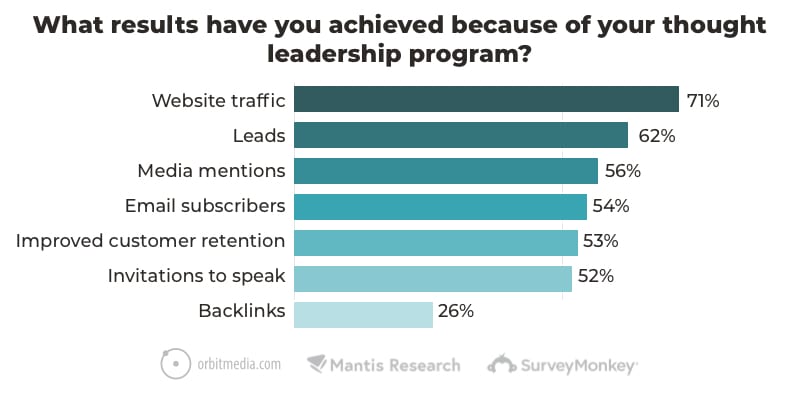
Why so few backlinks? That response is unexpected, especially since many of the aspects of thought leadership lead directly to this kind of outcome: original research, press mentions, high-visibility messages. These are exactly the ingredients for strong off-site SEO!
If 56% are driving mentions but only 26% are winning backlinks, the 30% of respondents in that gap need to read this article: How to turn press mentions into links through link reclamation.
Note: In the coming months, this blog will publish a guide for using thought leadership content specifically for SEO outcomes. Stay tuned, readers!
How popular is the thought leadership strategy?
Thousands of brands are publishing big content, big ideas and original research. Many define this work as thought leadership, even if it doesn’t come from any particular personal brand or offer strong opinions.
The majority of survey respondents report that their companies are prioritizing this type of content marketing. Beyond that, nearly half of the respondents (47%) reported that as individuals, they strive to be thought leaders themselves.
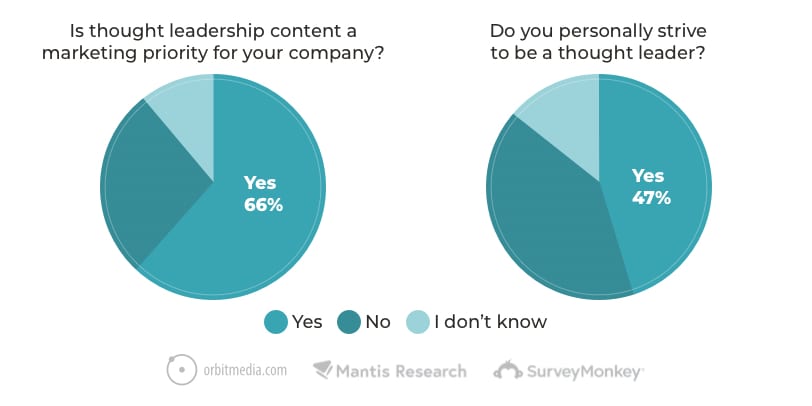
A lot of people call themselves thought leaders. In fact, a quick search for “thought leader” in LinkedIn turns up 1,000,037 people. That’s a lot of leaders.
There is a debate about this. Should you use the term to describe yourself? Or is it best to let others give you the label?
Regardless, I think it’s fantastic that so many people are striving to be leaders in their lives. People are working hard to share their expertise, become more visible as professionals and put more ideas out into the world. Love or hate the label, we should respect the motive behind it. It says “I’m trying to make a difference.”
So let’s pause to consider some practical ways to grow your personal brand as an expert. Each of these is available to everyone, everyday, at no cost.
15 ways to become a more visible expert
- Polish your LinkedIn profile to perfection.
- Ask for endorsements and recommendations.
- Google yourself. Like what you see? If not, manage your personal SEO.
- Conduct a study. Write about it for a trade publication.
- Write deep, comprehensive and practical articles.
- Share more often on social media.
- Create a social media video weekly.
- Network with and collaborate with other experts.
- Start a mastermind group with other experts.
- Offer to speak to classes at local schools.
- Go to conferences and host a breakfast. Eggs for experts.
- Start a monthly meetup. Present on a topic and find others to present.
- Pitch guest posts to relevant blogs.
- Write every day.
- Keep track of your growing “Lifetime body of work” (LBOW) and let that list motivate you to keep going with ever greater quality and quantity!
It’s up to each of us to create a plan and take actions to reach our goals.
This brings us to our final datapoint, the big question about the key qualifiers. We asked which of these qualities was essential, nice to have or not important. When we group the answers into categories, you can see the aspects of thought leadership prioritized.
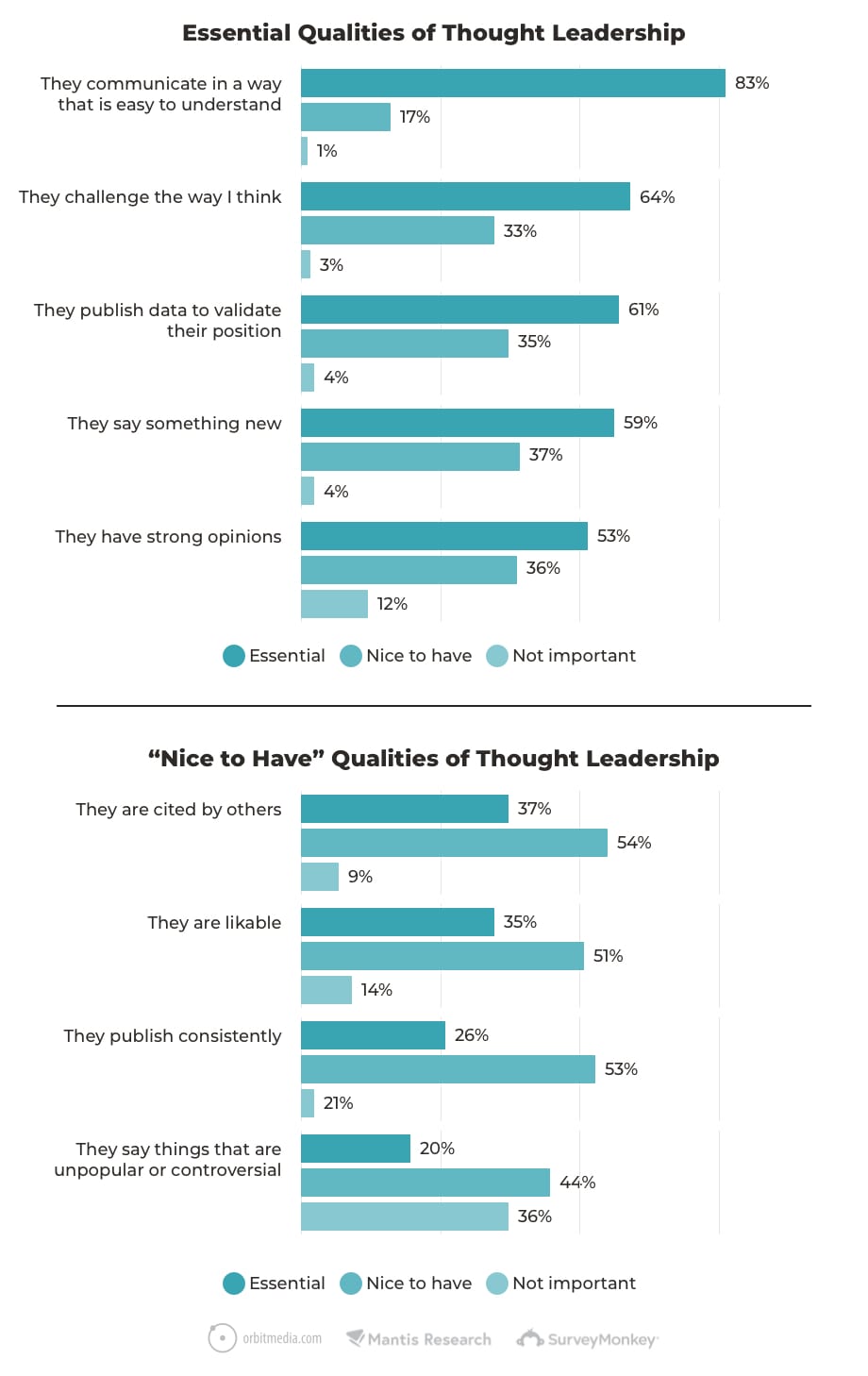
Let’s summarize that into two sentences.
- To be a thought leader, you must… clearly communicate challenging new ideas, back them up with data and have a strong point of view.
- And it doesn’t hurt if… you’re a likable person who publishes consistently, gets mentioned by others and doesn’t shy away from controversial issues.
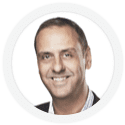 |
rob mitchell, ceo, LONGITUDE“Thought leadership is about ideas, but those ideas need to have a clear direction and impact on the audience. The content needs to inform by adding to the conversation, but that is the bare minimum it needs to do. The best thought leadership also influences behavior and, ideally, inspires the audience. It presents authority by positioning your brand as an expert, but also shows empathy by demonstrating an awareness of the key challenges and priorities facing business audiences.“ |
More examples of thought leadership definitions
We don’t expect that this survey will settle the debate about the definition of thought leadership. The fights in bars and at conference after-parties will continue.
To add fuel to that fire, we’re including a few more example definitions of thought leadership here.
“Free deliverables organizations or individuals produce on a topic they know a lot about and feel others can benefit from having their perspective on. Thought Leadership, in this context, does not include content primarily focused on describing an organization’s products or services.” – Edelman, B2B Thought Leadership Impact Study
“An individual or firm that is recognized as an authority in a specialized field and whose expertise is sought and often rewarded.” – Wikipedia
“Thought leaders are informed opinion leaders and the go-to people in their field of expertise. They are trusted sources who move and inspire people with innovative ideas; turn ideas into reality, and know and show how to replicate their success.” – Denise Brosseau, Thought Leadership Lab
“Original insight that engages senior audiences and has a clear marketing rationale” – Longitude, Thought Leadership Trends 2019
About the data: 100% of survey respondents were marketers, so this data is focused on thought leadership marketing. There are purists who rise above marketing and think about thought leadership in the context of society. I understand. But here our context is content and marketing!




